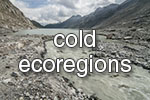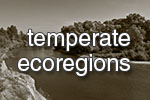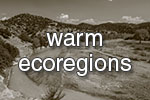Rivers in cold ecoregions - overview
The pristine status
 Click to enlarge
The main common character of rivers in cold ecoregions is cool water temperature throughout the year, which supports high oxygen concentrations. Woody riparian vegetation is often naturally lacking, and the river bed may be covered by ice and snow for several months. Extended low temperatures result in extensive ice cover for long periods of the year, significantly affecting physical, chemical, and biological processes in aquatic ecosystems. Low levels of precipitation generally occur throughout the Arctic and most of this falls as snow, resulting in limited and highly episodic local runoff. The main common character of streams and rivers in cold ecoregions is their low water temperature throughout the year, which supports high oxygen concentrations. Rivers that are fed primarily by glaciers are physically dynamic and nutrient-poor, and as such offer challenging environments for primary production and invertebrate communities. Consequently, macrophytes and benthic algae are poorly developed or completely lacking in winter. Fish and invertebrates are adapted to cold temperatures; their life cycles being synchronised with the ice-free period. Nevertheless, most species are widely distributed in Northern Europe, since time since the Pleistocene was not sufficient for the development of endemic species.
Click to enlarge
The main common character of rivers in cold ecoregions is cool water temperature throughout the year, which supports high oxygen concentrations. Woody riparian vegetation is often naturally lacking, and the river bed may be covered by ice and snow for several months. Extended low temperatures result in extensive ice cover for long periods of the year, significantly affecting physical, chemical, and biological processes in aquatic ecosystems. Low levels of precipitation generally occur throughout the Arctic and most of this falls as snow, resulting in limited and highly episodic local runoff. The main common character of streams and rivers in cold ecoregions is their low water temperature throughout the year, which supports high oxygen concentrations. Rivers that are fed primarily by glaciers are physically dynamic and nutrient-poor, and as such offer challenging environments for primary production and invertebrate communities. Consequently, macrophytes and benthic algae are poorly developed or completely lacking in winter. Fish and invertebrates are adapted to cold temperatures; their life cycles being synchronised with the ice-free period. Nevertheless, most species are widely distributed in Northern Europe, since time since the Pleistocene was not sufficient for the development of endemic species.
Human impact
Rivers in cold ecoregions are the least impacted aquatic ecosystems in Europe. However, many arctic freshwater systems are exposed to multiple environmental stressors or perturbations including point- and/or non point-source pollution (e.g., long-range aerial transport of contaminants); altered hydrologic regimes related to impoundments and diversions; water quality changes from landscape alterations (e.g., mining, oil and gas exploration); and biological resource exploitation (e.g., subsistence and commercial fisheries and harvesting of waterfowl and mammals; to name a few. These stressors, along with climate variability, can synergistically contribute to the degradation of biological diversity at the species, genetic, and/or habitat–ecosystem levels.
Climate change impact
Climate Change is predicted to be especially pronounced in high altitude and/or latitude systems, where it is expected to have particularly marked effects on the biota for several reasons: (1) these areas often have low organismal density, low species diversity and organisms with slow generation times, so there is less scope for adaptation; (2) many organisms are close to the edge of their physiological tolerance; (3) these habitats will shrink and become increasingly fragmented as warming proceeds, reducing the regional pool of cold-water refugia.
Warming in the mid- to high-latitudes is already occurring at two to three times the rate of the global average, and in mountainous regions, particularly at higher-elevations, recent data show increased magnitude and rate of warming with extensive loss of glaciers and snowpack. It is predicted that the loss of glaciers will result in a shift of water sources from snow/ice melt dominated to snow melt, rain and groundwater dominated during summer, and the flow regime will be similar to the nivo-pluvial regimes of lower Alpine regions. Summers could be warmer and dryer, although the climatic effect is expected to be less than in winters. More precipitation is expected to fall as rain instead of snow in locations where the historical air temperature has been near freezing. Periods with extreme weather are likely to become more frequent, and the prevalence and severity of extreme events such as floods and droughts are expected to increase. Hydrological systems are likely to be affected by increased runoff and earlier spring peak discharge in many glacier and snow-fed rivers (Jonsson & Jonsson, 2009).
Further reading
- Brown LE, Hannah DM, Milner AM (2007) Vulnerability of alpine stream biodiversity to shrinking glaciers and snowpacks. Global Change Biology, 13, 958–966. link to article
- Muhlfeld CC, Giersch JJ, Hauer FR, et al. (2011) Climate change links fate of glaciers and an endemic alpine invertebrate. Climatic Change, 106, 337–345. link to article
- Uehlinger U, Robinson CT, Hieber M, Zah R (2009) The physico-chemical habitat template for periphyton in alpine glacial streams under a changing climate. Hydrobiologia, 657, 107–121 link to article
- Jacobsen D, Milner AM, Brown LE, Dangles O (2012) Biodiversity under threat in glacier-fed river systems. Nature Climate Change, 2, 361–364. link to article









